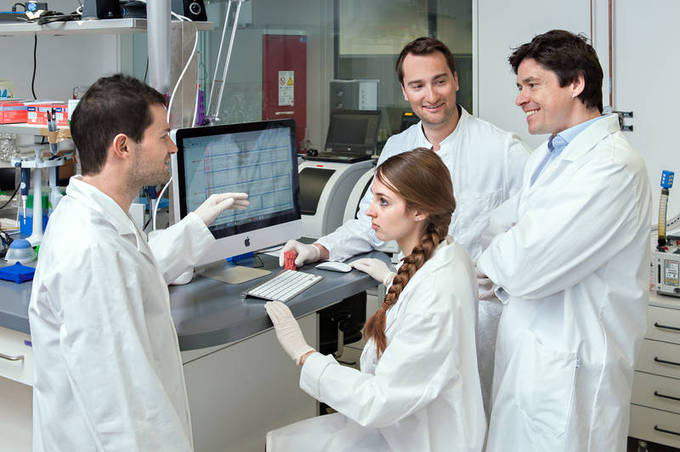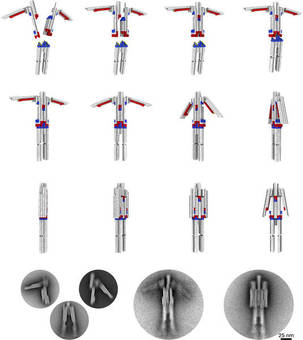Winkender Nanoroboter signalisiert neue Flexibilität im “DNA-Origami”
2015-03-27 – Nachrichten aus dem Physik-Department

“DNA Origami”, so die an die japanische Kunst des Papierfaltens angelehnte Bezeichnung seines Forschungsgebiets, bewegt sich laut TUM-Professor Hendrik Dietz mit Riesenschritten in Richtung praktischer Anwendungen. Der Wissenschaftler wurde erst vor ein paar Wochen für seinen Beitrag zu dieser dynamischen Entwicklung mit dem wichtigsten deutschen Forschungspreis, dem Gottfried Wilhelm Leibniz-Preis, ausgezeichnet.
In den letzten Jahren hat Dietz mit seiner Arbeitsgruppe eine ganze Reihe von Meilensteinen hinsichtlich der Anwendbarkeit von DNA-Nanomaschinen erreicht: In seinem Labor entstanden unter anderem synthetische Membrankanäle aus DNA; die Forscher konnten die nötige Zeitspanne für die Selbstmontage der DNA-Bausteine von einer Woche auf einige Stunden verkürzen und Ausbeuten von nahe 100 Prozent realisieren; und ihnen gelang der Nachweis, dass extrem komplexe Strukturen tatsächlich mit der vorab definierten Genauigkeit im Sub-Nanometerbereich realisiert werden können.
All diese Vorstöße nutzen die Methode der DNA-Basenpaarung, um festzulegen, wie sich die in einer Flüssigkeit gelösten, einzelnen DNA-Stränge und Baugruppen mit anderen verbinden würden. Nun präsentieren die Forscher einen neuen “Klebstoff”.

“Wenn man mit DNA-Basenpaaren baut, erhält man stabile Bindungen, die aber schwer wieder zu lösen sind“, erklärt Dietz. “Bisher musste man deshalb dynamische, also bewegliche Strukturen sehr einfach gestalten, um mit möglichst wenig Basenpaaren auszukommen. Diese Beschränkung fällt jetzt weg.“ Um eine größere Auswahl an DNA-Nanomaschinen mit beweglichen Teilen und mit potentiell anwendbaren Fähigkeiten zu ermöglichen, adaptierte das Team zwei weitere Techniken aus dem biomolekularen Werkzeugkasten der Natur: Zum einen die Art und Weise, wie Proteine zueinander komplementäre Formen nutzen, um wie ein Puzzleteil an andere Moleküle anzudocken, und zum anderen ihre Fähigkeit, relativ schwache Kontaktwechselwirkungen auszuformen, die bei Bedarf schnell wieder aufgelöst werden können.
Bio-inspirierte Flexibilität
Für die nun in Science präsentierten Experimente ließen sich Dietz und seine Mitautoren – die Doktoranden Thomas Gerling und Klaus Wagenbauer sowie die Bachelorstudentin Andrea Neuner von der Munich School of Engineering der TUM – von einem Mechanismus inspirieren, mit dem Nukleinsäuremoleküle sich mit schwächeren Wechselwirkungen als mit Basenpaaren aneinander binden. In der Natur bilden sich solche schwache Bindungen beispielsweise wenn das RNA-basierte Enzym RNaseP ein sogenanntes Transfer-RNA Molekül “erkennt”: Die Moleküle werden dann über ihre komplementären Formen nah genug zueinander geführt – ähnlich einem andockenden Raumschiff – und „klicken“ in einen gebundenen Zustand.

Dietz’ neue Technologie imitiert diese Methode. Beim Bau einer beweglichen DNA-Nanomaschine programmieren die Forscher zunächst die Selbstmontage der dreidimensionalen, zueinander passend geformten Bausteine. Dann lässt sich ein schwacher, im Nahbereich wirkender Bindungsmechanismus – das Stapeln von Nukleinbasen – aktivieren, um diese Einheiten korrekt einzurasten. Mit drei verschiedenen Methoden lassen sich die Form und die Aktion der so erzeugten Objekte steuern. “Damit steht uns jetzt ein Portfolio von Wechselwirkungen mit klar abgestuften Bindungsstärken zur Verfügung, um mehrere Komponenten präzise in gewünschter Weise relativ zueinander zu positionieren,“ erklärt Dietz. Die Arbeitsgruppe stellte eine Serie von DNA-Objekten her, um einerseits die Möglichkeiten der Technologie aufzuzeigen und andererseits ihre Grenzen auszuloten. Die Erzeugnisse reichen von mikrometergroßen Fäden, die eine Ahnung von technologischen Flagellen – beispielsweise für die Fortbewegung – vermitteln könnten, bis hin zu Nanomaschinen mit beweglichen Teilen.
Anhand transmissionselektronen-mikroskopischer Aufnahmen eines nanoskaligen, der Form eines Menschen nachempfundenen Roboters können die Forscher zum Beispiel belegen, dass die Teile exakt wie vorgesehen zueinander passen. Außerdem zeigen die Bilder wie eine einfache Steuerungsmethode, nämlich die Veränderung der Konzentration positiver Ionen in der Lösung, aktiv zwischen verschiedenen Konfigurationen umschalten kann: Zerlegt oder montiert sowie mit geöffneten oder an der Seite des Roboters ruhenden Armen.
Als besonders robust herausgestellt hat sich eine weitere Methode, um ein DNA-Nanoobjekt zwischen verschiedenen strukturellen Zuständen umzuschalten – indem schlicht die Temperatur angehoben oder abgesenkt wird. In früheren Generationen von Nanoobjekten mussten für dieses Umschalten ein Teil der DNA-Basenpaare gezielt durch Zugabe weiterer DNA Moleküle getrennt und wieder verbunden werden. Die Systeme nutzten sich durch Verdünnung und durch Seitenreaktionen schon nach ein paar Schaltzyklen ab. Die vorliegende Veröffentlichung beschreibt nun einen scherenartigen Aktuator, der über einen Zeitraum von vier Tagen mehr als tausend temperatur-induzierte Schaltzyklen absolvierte, ohne jegliche Anzeichen von Alterung zu zeigen.
„Das zyklische Aufheizen und Abkühlen wäre ein Weg, um Energie in das System zu bringen,“ ergänzt Dietz. „Wenn es uns jetzt noch gelingt, das temperaturgesteuerte mechanische Auf- und Zuklappen unserer Objekte an einen sich kontinuierlich entwickelnden Prozess anzukoppeln – wie bei einer Ratsche zum Beispiel –, dann sollten wir in der Lage sein, Nanomaschinen zu bauen und sie auch anzutreiben.“
Fast so einfach wie LEGO
Die Erweiterung des Werkzeugkastens der DNA-Nanotechnologie um Komponenten mit komplementären Formen sowie um schwache Bindungen bringt auch an anderer Stelle einen Gewinn an Flexibilität. Die Programmierung der Selbstmontage über die Bildung von Basenpaaren mutet in etwa an wie das Schreiben eines Computerprogramms in Maschinensprache. Man hofft nun, dass der neue Ansatz die Weiterentwicklung von DNA-Origami in Richtung praktischer Anwendbarkeit deutlich vereinfacht – ganz so, wie das Aufkommen höherer Programmiersprachen die Software-Technologie vorangetrieben hat.
Es sei ein bisschen wie das Bauen mit LEGO, meint Dietz: „Man gestaltet die Komponenten komplementär zueinander, und das ist eigentlich schon alles. Der ganze Aufwand, der mit Basenpaar-Sequenzen getrieben werden muss, um die Komponenten zu verbinden, entfällt.“
Diese Arbeiten wurden unterstützt durch die Deutsche Forschungsgemeinschaft (DFG), durch die Excellence Cluster CIPSM (Center for Integrated Protein Science Munich) und NIM (Nanosystems Initiative Munich), den Sonderforschungsbereich (SFB) 863, das TUM Institute for Advanced Study, die TUM Graduate School of Science and Engineering, und die Munich School of Engineering; den European Research Council (ERC Starting Grant); und die Hans L. Merkle Stiftung.
Veröffentlichung
Weitere Informationen
Verwandte Meldungen
- Biophysiker Hendrik Dietz (36) erhält deutsche Spitzenauszeichnung – 10.12.2014
- Bewährungsprobe für DNA-Nanotechnologie – 14.12.2012
- Forscher konstruieren synthetische Membrankanäle aus DNA – 21.11.2012
Kontakt
- Prof. Dr. Hendrik Dietz
- Biomolekulare NanotechnologiePhysik-Department und Walter Schottky Institut / ZNNTechnische Universität MünchenAm Coulombwall 4a85748 GarchingTel.: +49 89 289-11615E-Mail: dietz@tum.de